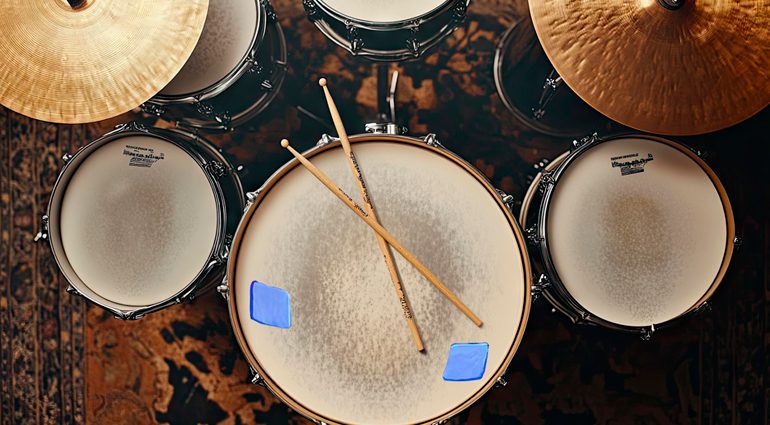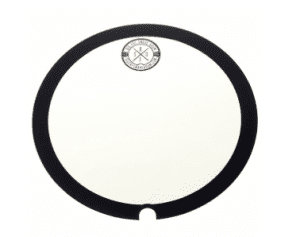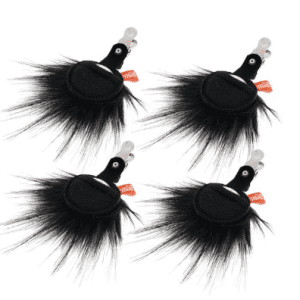
You’ve probably noticed it in many songs on social media and YouTube: heavily muted, very short, dry-sounding drum sounds are all the rage.
Snare drums and toms in particular can hardly sound “dead” enough for many drummers and producers. But why? 🤔

There is of course no single answer to this question and it doesn’t apply to all styles of music. However, a lot of it probably has to do with the general trend towards vintage sounds.
In the 50s to 70s, drums weren’t designed for a particularly long decay and open sound, nor was the recording technology. The sound was therefore spacious but compact.
Many modern drummers also play patterns and beats inspired by electronic music, which are characterized by rigorous sustain control, including hard gates. This has its origins in the analogue drum machine sounds of the 80s.
Sample culture also plays a role, as many samples originate from the aforementioned era of the 60s and 70s. To imitate this on an acoustic set, you need to think about controlling your sound, which brings us to the topic of dampening the drumheads.
How does dampening actually work?
When you hit a drum, you generate an energy impulse that the head dissipates by vibrating. A portion of the energy is also transferred to the rest of the drum via the bearing edge and hoop.
If you attach something to the head, you weigh it down, thereby reducing the amount of fast vibrations and, therefore, overtones. The amount of energy that travels into the shell is also reduced. As a result, even experienced listeners will have difficulties drawing conclusions about the drum itself if it is heavily dampened.
Here you can find all dampeners on thomann.de
The advantages of dampening for recording and production
In addition to the tonal aspects of sustain control, stronger dampening also offers some advantages when recording the drums. Hitting an open-tuned, undampened drum produces a loud attack (transient) followed by a series of slowly decaying harmonics.

If other drums and cymbals are added and the recording takes place in a normal, untreated room, the many layers of sounds can be difficult for the human ear to “sort”. The result is the dreaded muddy, undefined sound. This is why good drum recording is an art form.
Targeted, sometimes drastic dampening has therefore established itself as a practical solution. Even less experienced people can achieve great results without a perfectly treated drum room. Dampening also helps to improve signal separation, which is essential for post-processing. It is therefore perhaps no coincidence that this type of drum sound is so popular today, especially in times when more and more people record at home.
The Dead Snare: for hip hop, dance, electro, and all kinds of retro sounds
The percussive centrepiece of most productions is the snare drum, so let’s begin there. The easiest way to achieve an extremely short, dry, and compressed snare sound is … a tablecloth. This isn’t ideal in terms of handling, but there are great products that give you a stylish retro sound in the blink of an eye, such as the Rohema Mr Muff Muffin. It delivers a controlled attack and an extremely short, retro-like decay.
With their broader, more powerful attack, “The Original” drumheads from Big Fat Snare Drum are perfect for a “wet” disco sound. Compared to the Muffins, they have a much thicker Mylar film, which makes the transients much more aggressive.
Fat retro sound: “Dead” toms are fun
It goes without saying that what works well on snares works even more effectively on toms, as their natural decay is much longer. Here you should first ask yourself what intensity you prefer. Small dampeners applied only to the edges tend to reduce annoying overtones, while the “body” of the sound remains intact.
By using heavier dampeners and covering more of the surface area of the drumhead, you can shorten the sustain drastically. You should also consider how flexible you want to be with the dampening.
Duct tape, also known as gaffa tape, can be applied with pinpoint accuracy, but is rather difficult to remove. For a medium level of dampening, the practical MiniMuffs, which are also available in a set for toms, are a good choice.
Products that cover more of the head surface provide significantly more dampening. One very good option are MuffBites, which attach magnetically to the hoop or can be fixed to cast hoops using adapters. Besides the flexibility, their advantage is that they give the toms a compact, more focussed sound. Of course, all options that work well on toms are equally suitable for the snare drum.
For maximum dampening of the toms, you can opt for Mr.Muff Muffins, which cover the entire surface of the drum. These produce an extremely short sound with a softer attack, which is particularly suitable if you’re looking for a very vintage-inspired sound (think Ringo Starr). But they’re also great for playing fast figures and for precise listening during practice.
You are currently viewing a placeholder content from YouTube. To access the actual content, click the button below. Please note that doing so will share data with third-party providers.
Find all drum dampeners on thomann.de here
Are you a drummer looking for dampeners for your setup? Then browse our selection. We are always happy to advise you. Call us or send us an email:
Dead Drums: Conclusion
Heavily dampened snares and toms not only produce a less aggressive sound than open drums, they can also be played in a very controlled manner. By reducing the overtones, many dampening options bring out the low-frequency components, which translates to a subjectively fatter sound.
At the same time, dampened drums open up many options for miking and especially for post-processing, even in untreated recording spaces. The fact that most dampening products don’t cost a fortune is an added bonus.
Dead Drums: Your feedback
Do you have any other dampening tips for great-sounding “dead drums”? Feel free to share them in a comment!
You are currently viewing a placeholder content from Facebook. To access the actual content, click the button below. Please note that doing so will share data with third-party providers.
More InformationYou are currently viewing a placeholder content from Instagram. To access the actual content, click the button below. Please note that doing so will share data with third-party providers.
More InformationYou are currently viewing a placeholder content from X. To access the actual content, click the button below. Please note that doing so will share data with third-party providers.
More Information














